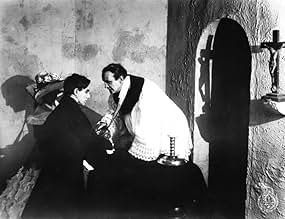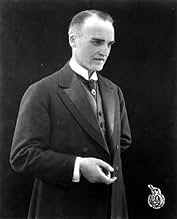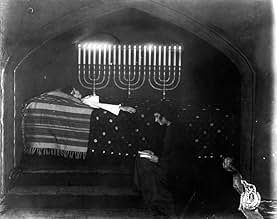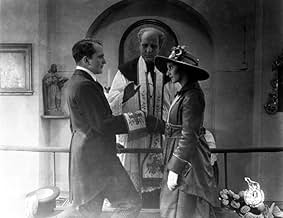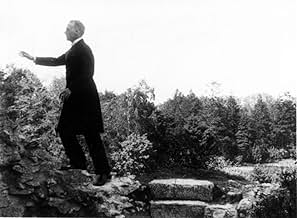IMDb-BEWERTUNG
6,6/10
1128
IHRE BEWERTUNG
Füge eine Handlung in deiner Sprache hinzuA judge sees his illegitimate daughter facing a trial for the murder of her newborn child, also out of wedlock. He is certain that she will be sentenced to death.A judge sees his illegitimate daughter facing a trial for the murder of her newborn child, also out of wedlock. He is certain that she will be sentenced to death.A judge sees his illegitimate daughter facing a trial for the murder of her newborn child, also out of wedlock. He is certain that she will be sentenced to death.
- Regie
- Drehbuch
- Hauptbesetzung
Carl Walther Meyer
- Rigsherre von Sendlingen
- (as Carl Meyer)
Empfohlene Bewertungen
Praesidenten is a film about the crucial conflict between the (conservative) codes of society and individual moral.
It tells the story of a grandfather, father and son of a well respected family who all make the same mistake and fall in love with a common girl.
They all have to resolve the problem in a way acceptable to the society they live in but must consequently suffer the inner guilt that inevitably follows.
Finally, late in his life the son, whose a respected judge in a small town, gets a chance to redeem himself and his ancestors by doing the right thing morally but also severely breaking the law in doing so.
This highlights the conflict between the personal and the societal spheres of right and wrong in a spectacular way, especially as Dreyer depicts the other local men of power as only concerned with how the incident would affect their status in society.
Dreyer uses flashback- structure in a very efficient and economical way to build the comparisons between the different times portrayed in the film. Furthermore: in this our digital age of fast editing and overflow of image it is most gratifying to see a film that has a complex point to make and manages to do that almost effortlessly with a minimum of "hassle". The direction is so economic it almost hides the mastery of cinematic vision behind it to the untrained eye.
It tells the story of a grandfather, father and son of a well respected family who all make the same mistake and fall in love with a common girl.
They all have to resolve the problem in a way acceptable to the society they live in but must consequently suffer the inner guilt that inevitably follows.
Finally, late in his life the son, whose a respected judge in a small town, gets a chance to redeem himself and his ancestors by doing the right thing morally but also severely breaking the law in doing so.
This highlights the conflict between the personal and the societal spheres of right and wrong in a spectacular way, especially as Dreyer depicts the other local men of power as only concerned with how the incident would affect their status in society.
Dreyer uses flashback- structure in a very efficient and economical way to build the comparisons between the different times portrayed in the film. Furthermore: in this our digital age of fast editing and overflow of image it is most gratifying to see a film that has a complex point to make and manages to do that almost effortlessly with a minimum of "hassle". The direction is so economic it almost hides the mastery of cinematic vision behind it to the untrained eye.
"Praesidenten" is the first film of the great Danish film director Carl Theodor Dreyer and, for this German count, this debut is a perfect example of Dreyer's film style. It's one, with degrees of variation, he would maintain in his silent films as well as in his talkie career.
"Praesidenten" is a film perfectly constructed (the film is divided into three different but interrelated parts). Flashbacks are used to depict the terrible story of Danish noblemen who dare to fall in love with common girls; such huge mistakes will have serious consequences for the main characters as Herr Von Sendlingen says to his son at the beginning of the film, "never marry a commoner, for no good ever comes of it, naught but curses and remorse " ah, wise words, indeed!.
"Praesidenten", besides having a solid and narrative film structure very well rendered, has an elegantly slow pace, this is very characteristic in Herr Dreyer's films, film cadences and pauses endow the story with intensity and emotive nature, showing the vicissitudes of three generations of a family broken due to impossible or imprudent relationships. When at the end of the film the main character has the opportunity to atone his sins and make amends with the past, he finally carries the burden of stricter convictions and codes of honor.
"Praesidenten" is a solid debut, one with graceful and delicate pacing a perfect example of the Herr Dreyer oeuvre.
And now, if you'll allow me, I must temporarily take my leave because this German Count, as President of the "Associated Aristocrats Foundation" must attend another decadent meeting.
Herr Graf Ferdinand Von Galitzien
"Praesidenten" is a film perfectly constructed (the film is divided into three different but interrelated parts). Flashbacks are used to depict the terrible story of Danish noblemen who dare to fall in love with common girls; such huge mistakes will have serious consequences for the main characters as Herr Von Sendlingen says to his son at the beginning of the film, "never marry a commoner, for no good ever comes of it, naught but curses and remorse " ah, wise words, indeed!.
"Praesidenten", besides having a solid and narrative film structure very well rendered, has an elegantly slow pace, this is very characteristic in Herr Dreyer's films, film cadences and pauses endow the story with intensity and emotive nature, showing the vicissitudes of three generations of a family broken due to impossible or imprudent relationships. When at the end of the film the main character has the opportunity to atone his sins and make amends with the past, he finally carries the burden of stricter convictions and codes of honor.
"Praesidenten" is a solid debut, one with graceful and delicate pacing a perfect example of the Herr Dreyer oeuvre.
And now, if you'll allow me, I must temporarily take my leave because this German Count, as President of the "Associated Aristocrats Foundation" must attend another decadent meeting.
Herr Graf Ferdinand Von Galitzien
This film is very interesting for various reasons. I will here look briefly at its style, which was explicitly made by Dreyer (confirmed in a letter to Erik Ulrichsen 11th March 1958, now in the Danish Film Museum) to make the interiors reflect the characters. For this, he modeled the sets after paintings by Vilhelm Hammershøi and James Whistler. This is very apparent if one looks at Whistler's portrait of his Mother against a gray wall, and the many Hammershøi paintings where he balances the model(s) also against gray, cool blue or white walls decorated with a few small portraits strictly arranged. I would also like to add that a lot of the white faces and hands, which Dreyer often frames in almost complete darkness, reminds me of how the graphic work by Edvard Munch can make any face look like a premature death mask. There is certainly in this film much interplay between the Nordic darkness of the soul and the barren interiors of the late aristocracy. These arrangements make the film appear as a well thought out study of how to balance painterly and cinematographic style. However, many of these carefully constructed scenes are very short. I would assume that longer takes would make for a very much more beautiful and contemplative film, but alas it would also slow down the hectic and melodramatic plot, which just gets more frantic with each scene, ending in a tour de force of cross cutting a la Griffith. So in a way the plot kills the style. Oh well.
The current version was created in 1999 from the original nitrate negative and released on DVD in 2004 by the Danish Film Institute. It is tinted in amber, blue and red. Compared with film stills I have seen in black and white, the DVD looks very dark. For example the scene when Karl Victor reads the letter informing him that it is his daughter that will be prosecuted for infanticide, the wallpaper behind him is completely obscured, making the white passepartout framing the portrait on the wall shine in the darkness. In the still of the same scene you can clearly see the pattern in the wallpaper around the picture, making the whole scene more naturally lighted. Since the lightning in the film as a whole is full of dark imagery, this loss of detail makes the film look more expressionistic and gloomy than originally intended. Of course, that might only make it more interesting for fans of Nosferatu, Vampyr and other Gothic nightmares. But Præsidenten is not a Gothic tale, but rather a moral melodrama typical of its time, with echoes of Ibsen, Strindberg and Söderberg (writer of Gertrud). But as seen in the current version, it certainly looks Gothic - and some might find its charm just because of that.
The current version was created in 1999 from the original nitrate negative and released on DVD in 2004 by the Danish Film Institute. It is tinted in amber, blue and red. Compared with film stills I have seen in black and white, the DVD looks very dark. For example the scene when Karl Victor reads the letter informing him that it is his daughter that will be prosecuted for infanticide, the wallpaper behind him is completely obscured, making the white passepartout framing the portrait on the wall shine in the darkness. In the still of the same scene you can clearly see the pattern in the wallpaper around the picture, making the whole scene more naturally lighted. Since the lightning in the film as a whole is full of dark imagery, this loss of detail makes the film look more expressionistic and gloomy than originally intended. Of course, that might only make it more interesting for fans of Nosferatu, Vampyr and other Gothic nightmares. But Præsidenten is not a Gothic tale, but rather a moral melodrama typical of its time, with echoes of Ibsen, Strindberg and Söderberg (writer of Gertrud). But as seen in the current version, it certainly looks Gothic - and some might find its charm just because of that.
"The President", known as Carl Theodor Dreyer's first feature-length film, includes a trial scene, solved in a traditional way, a strong contrast with his famous masterpiece "Passion of Jeanne d'Arc". In general, the "mise-en-caméra" is rather conventional, except for a couple of shots, both related to romantic situations in which the filmmaker was "inspired": one is a overhead shot of a kiss, the other two lovers' reunion on a bridge reflected on a pond. There are a few silly distracting shots dealing with puppies; one or two inserts seemingly erroneous, but in any case, it is an enjoyable viewing, and Dreyer's ethical considerations and spiritual leaning –which reached a sublime level in "Ordet"- are already sketched here.
Dreyer himself was a child born out of wedlock and given to adoption by an unwed woman who died soon thereafter. No wonder the sufferings of a woman are the marrow of many of his films.
The Danish woman is widely considered to be a rather high-spirited and free-minded creature. There are several films in the series issued by the Danish Film Intitute which show how women take things in their own hands, choose their men, inflict revenge upon them. But that is not the case in Præsidenten. This is a full blown melodrama about the constant sufferings of women, generation after generation. A pretty outdated concept by 1919 standards, and a pretty moralizing version of the eternal story of men taking advantage of women, having their way with them and abandoning them. There's a lot of honor and duty involved int the style of a proper Gilbert and Sullivan operetta, but unlike G&S, the film takes itself much too seriously. There are some highly unmotivated actions and a very, very weird scene, that seems to be either totally butchered or else the Danes lacked the knowledge of how babies are born completely - the barely pregnant governess is driven into the night, she collapses in the woods... and the next morning she is found lying there with the dead child by her side! So naturally she is blamed with infanticide at once. I don't know how exactly, but I find it hard to believe that reproduction worked like that. There's also a lot of bad make-up as all the young men also play themselves in their ripe years, so overall the results aren't very convincing. A somewhat tedious production, but worthy a viewing.
The Danish woman is widely considered to be a rather high-spirited and free-minded creature. There are several films in the series issued by the Danish Film Intitute which show how women take things in their own hands, choose their men, inflict revenge upon them. But that is not the case in Præsidenten. This is a full blown melodrama about the constant sufferings of women, generation after generation. A pretty outdated concept by 1919 standards, and a pretty moralizing version of the eternal story of men taking advantage of women, having their way with them and abandoning them. There's a lot of honor and duty involved int the style of a proper Gilbert and Sullivan operetta, but unlike G&S, the film takes itself much too seriously. There are some highly unmotivated actions and a very, very weird scene, that seems to be either totally butchered or else the Danes lacked the knowledge of how babies are born completely - the barely pregnant governess is driven into the night, she collapses in the woods... and the next morning she is found lying there with the dead child by her side! So naturally she is blamed with infanticide at once. I don't know how exactly, but I find it hard to believe that reproduction worked like that. There's also a lot of bad make-up as all the young men also play themselves in their ripe years, so overall the results aren't very convincing. A somewhat tedious production, but worthy a viewing.
Wusstest du schon
Top-Auswahl
Melde dich zum Bewerten an und greife auf die Watchlist für personalisierte Empfehlungen zu.
Details
- Laufzeit1 Stunde 25 Minuten
- Sound-Mix
- Seitenverhältnis
- 1.33 : 1
Zu dieser Seite beitragen
Bearbeitung vorschlagen oder fehlenden Inhalt hinzufügen


